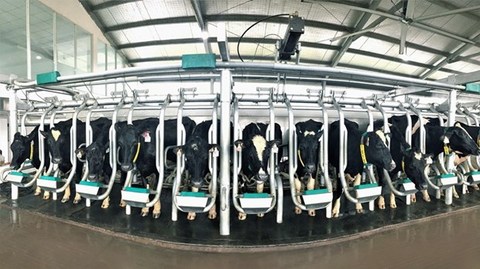
Vinamilk imports cows from New Zealand to serve its milk production for local consumption and exports. — VNA/VNS Photo
Viet Nam’s dairy makers are accessing more opportunities to increase exports, but companies need to enhance their competitiveness in foreign markets and develop a concentrated production scale.
The export value of dairy products and fresh milk reached US$48.6 million in the first three months of the year, with the main export markets in Iraq, Hong Kong, mainland China, Afghanistan, the Philippines and other countries, including UAE, Laos, Myanmar and Japan.
Exports are expected to grow strongly this year as domestic enterprises are targeting expansion of their overseas markets.
Two of Viet Nam's dairy giants, Vinamilk and TH True Milk, have been expanding investment in other countries.
Vinamilk has invested in fresh milk and dairy product and processing in the US, New Zealand, Cambodia, Poland, Laos and Myanmar.
This year Vinamilk invested in its first factory in Myanmar to meet the increasing demand for milk and milk products there.
Milk consumption in Myanmar, which has a population of 55 million, is 10 litres per head per year, very low compared to other markets in the region, such as Thailand with 36 litres and Malaysia with 53 litres.
TH True Milk recently invested in a US$2.7 billion project to raise cows and process milk in Russia.
Exports of milk and dairy products are also expected to increase sharply in the future after the Protocol on exports of Vietnamese milk and dairy products to China, a market of 1.4 billion, was inked on April 26
According to the Food and Agriculture Organisation's 2018 global dairy market report, China produced 25.6 million tonnes of milk, down 1.1 per cent from 2017. In order to meet domestic consumption of milk and dairy products, the country annually imports 14.6 million tonnes of milk.
Nguyen Quoc Toan, acting director of the Ministry of Agriculture and Rural Development's Agro Processing and Market Development Agency, told local media at a recent conference in Ha Noi that there was great potential for exporting milk and dairy products to China.
However, Toan said that Vietnamese exporters faced challenges because milk from Australia and New Zealand has occupied a large market share in the Chinese market. “Vietnamese milk exports to China are promising but they will face competition from these two giants."
“To expand Viet Nam’s export market in the coming time, businesses in particular and the dairy industry in general should prioritise the modernisation of milk and dairy product processing technology that meets the requirements of China in the spirit of the Protocol signed recently,” Toan said. "At the same time, product development should meet the demand of other potential markets such as Indonesia, Malaysia, the Philippines and Singapore.”
The chairman of TH Group, Ngo Minh Hai, told diendandoanhnghiep.vn that the door for milk and dairy product exports to the Chinese market has initially opened, but not all businesses in Viet Nam's dairy industry would be able to enter.
“China has technical barriers that force us to overcome. Companies must ensure two important requirements, including maintaining quality and product standards, and ensuring origin,” Hai said.
The deputy head of MARD’s Department of Livestock Production, Tong Xuan Chinh, said the Ministry of Industry and Trade should improve planning and supervision of the construction of milk processing plants, which must match the volume of local cattle herds and the consumption market.
Chinh said MARD would create a new policy to support the development of dairy farming and milk processing in the 2020-30 period, promoting the industry as well as the export of milk and dairy products.
“The policy will be submitted to the Prime Minister for approval,” he added.
Chinh said that links between cow breeders and milk exporters should be tightened. Fresh milk from breeders has to be sold to businesses as soon as possible because breeders lack preservation facilities. If they sell milk to the market, it is only a small amount.
Dairy enterprises need to reorganise the production of dairy cows in a closed chain, controlling disease safety and food safety.
At the same time, modernisation of facilities, raw milk purchasing centres, and modern milk factories must be established to meet the export demand of many markets, he added. — VNS